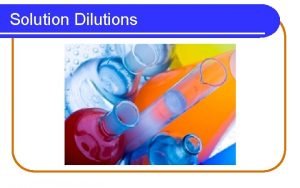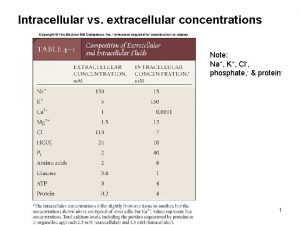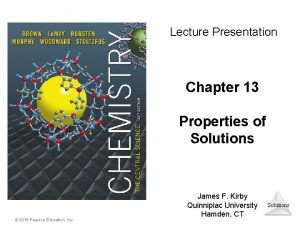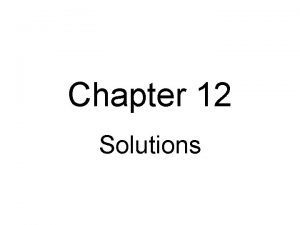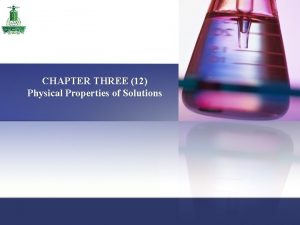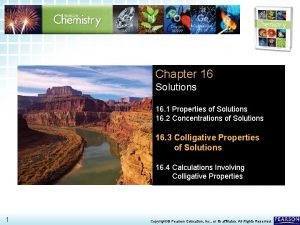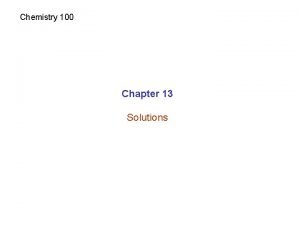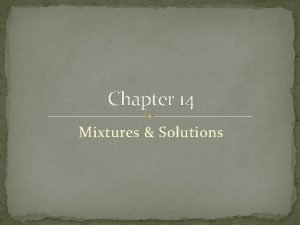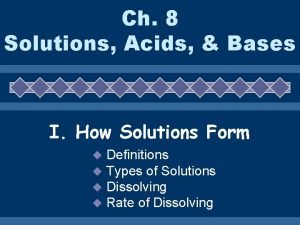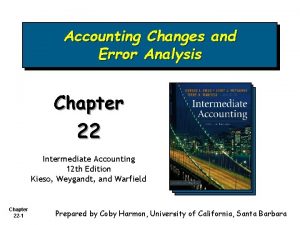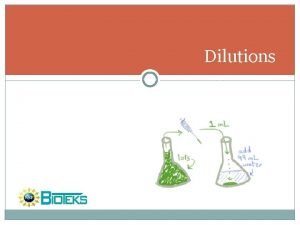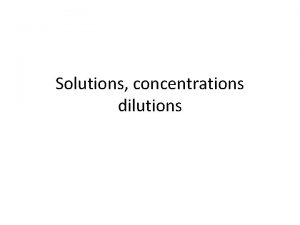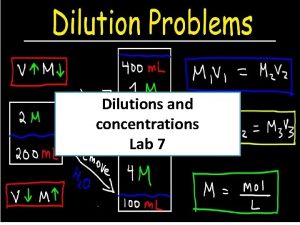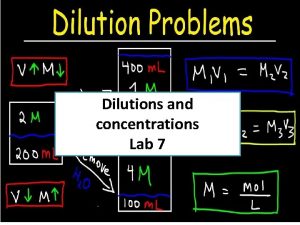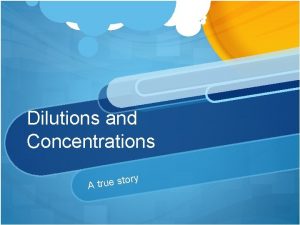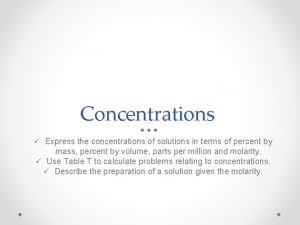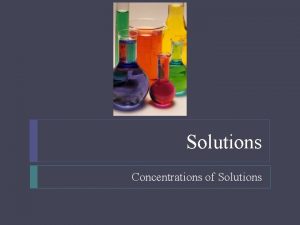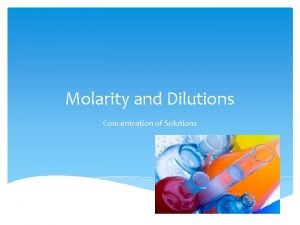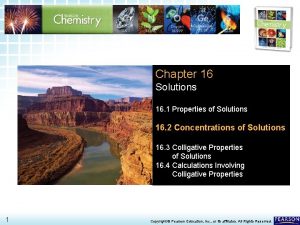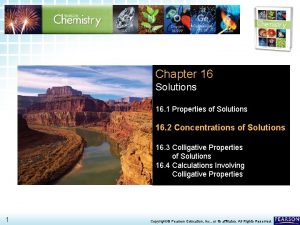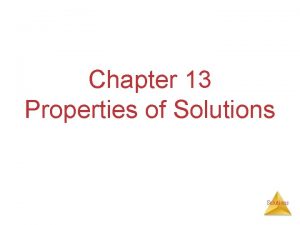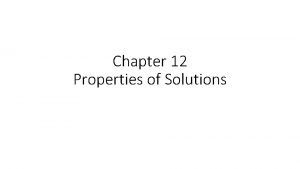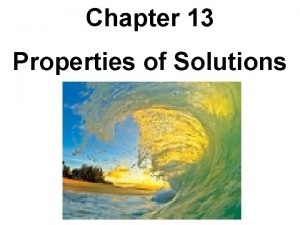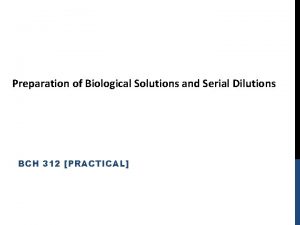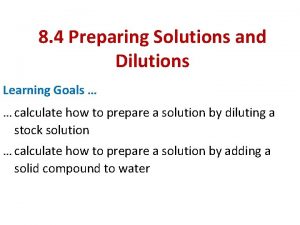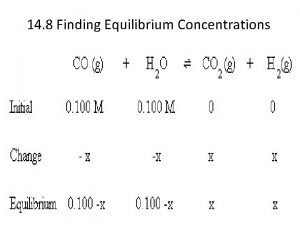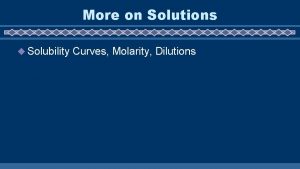CHAPTER 16 SOLUTIONS Properties Concentrations and Dilutions REVIEW































- Slides: 31

CHAPTER 16: SOLUTIONS Properties, Concentrations, and Dilutions

REVIEW Solute and Solvent Solute is the substance being dissolved. Solvent is the substance doing the dissolving. Example: Salt and Water. We dissolve salt in water. Therefore, the salt is the solute and the water is the solvent. Why is water called the universal solvent?

PART 1: PROPERTIES OF SOLUTIONS Forming a Solution • The composition (what they are made out of) of the solvent and solute determine whether a substance will dissolve. How FAST will the substance dissolve? • • This depends on three things: 1. Stirring: Increase of decrease rate? 2. Temperature: Increase or decrease rate? 3. Particle Size: The more surface area exposed, the faster it will dissolve.

PART 2: SOLUBILITY What amount of a substance will dissolve? Particles move from a solid into a solution. But how much can be dissolved? Solubility describes the amount of substance that can be dissolved by a certain quantity of a solvent at a certain temp and pressure until the solution becomes saturated.

SOLUBILITY Different Types of Solutions: • Saturated Solution: The maximum amount of solute that can be dissolved at a specific temp and pressure. • Unsaturated Solution: A solution that contains less solute than required to be a saturated solution and a certain temp and pressure. • Supersaturated Solution: contains more solute than it can theoretically hold at a given temperature. • Miscible Solution: when two liquids will dissolve into one another. There is no separation. • Immiscible: liquids that are not soluble in each other. You can tell

SOLUBILITY Miscible Water and Acetone Immiscible Oil and Water

SOLUTIONS Supersaturated Solution

GOOD NEWS: BREAKING BAD FANS Learn how to make your own rock candy using Chemistry at home. (AKA Crystal Meth… Not really. Just kidding. ) http: //vid eo. about. com/che mistry/H ow-to. Make. Rock. Candy. ht m

ROCK CANDY EXPLAINED What do YOU think? What type of solution is being utilized? How are they making that solution?

FACTORS THAT AFFECT SOLUBILITY • 1. Temperature: Solubility of MOST substances increases as temperature increases. • You can dissolve more solute in the solvent as you increase the temperature. Think about how we made our rock candy. • EXCEPTION: Gas solubility increases as temperature decreases.

FACTORS THAT AFFECT SOLUBILITY • 2. Pressure: Changes in pressure doesn’t affect the solubility of solids and liquids, but it greatly influences the solubility of gases. • As pressure increases, the solubility of gases also increases. Use Henry’s Law for calculations. • S = solubility • P = pressure • Directly Proportional

SOLUBILITY OF SOLUTIONS How would I describe solubility in terms of UNITS? Solubility is usually expressed in grams of solute per 100 g of solvent. • Example: 36 g of sodium chloride in 100 g of water at 25 deg. C. • Examples in terms of saturation: If 36 g of Na. Cl is added to 100 g water, it will dissolve completely, but if I added 1 more gram of Na. Cl, only 0. 2 g of that will dissolve. Therefore, 36. 2 g of Na. Cl in 100 g of water is a SATURATED solution. • How would I make it super saturated? ?

PART 3: CONCENTRATIONS Concentration: a measure of the amount of solute that is dissolved in a given quantity of solvent. Dilute Solution: a weak concentration. Contains small amount of solute. Concentrated Solution: strong concentration. Contains a large amount of solute. Concentrated Dilute

CONCENTRATIONS MOLARITY Moles of solute dissolved in 1 Liter of solution.

LET’S MAKE A SOLUTION Let’s determine the molarity of a solution that we make. Let’s start with 10 grams of sodium chloride and add it to a 1 -L volumetric flask half filled with distilled water.

LETS MAKE A SOLUTION Swirl the flask carefully to dissolve the solute.

LETS MAKE A SOLUTION Fill the flask with water exactly to the 1 -L mark. What is the concentration of the solution in molarity?

Answer: 0. 171 M

LETS MAKE A SOLUTION This will work with ANY volumetric flask. Big or small. We can then calculate the molarity (concentration) of our solution. • How do we convert m. L to L?

WHAT IF YOU KNOW THE MOLARITY? Find the number of moles of solute in a solution… • We can also convert moles to grams.

DILUTIONS Diluting a solution reduces the number of moles per unit volume. The number of moles of solute remains unchanged. Dilution equation:

DILUTIONS To prepare 100 ml of Mg. SO 4 from a stock solution of 0. 171 M Na. Cl, a student first measures 10 m. L of the stock solution with a 10 -m. L pipet.

DILUTIONS She then transfers the 10 m. L to a 100 -m. L volumetric flask.

DILUTIONS Finally, she carefully adds water to the mark to make 100 m. L of solution. What is the final concentration?

Use M 1 x V 1 = M 2 x V 2 Answer: 0. 0171

TO MEASURE VOLUME Some volume measuring devices… Buret Graduated Cylinder Volumetric Flask Glass Pipets

DILUTION CALCULATION

PERCENT CONCENTRATIONS OF SOLUTIONS These are not as common as molarity, but are used sometimes. Percent by volume: Percent by mass:

PERCENT CONCENTRATION CALCULATIONS Percent by volume: (volume/volume)

PERCENT CONCENTRATION CALCULATIONS Percent by mass: (mass/mass) • Suppose you want to make a 2000 g solution that has a 2. 8% (m/m) concentration of glucose in water. • How many grams of glucose should you use?

CLASS WORK Page 499 # 42, 44, 46, 48, 49 a, 51, 52, 53 a, b, 54 a, 55 a
 Dilutions worksheet
Dilutions worksheet Cl extracellular concentration
Cl extracellular concentration Chapter 13 properties of solutions
Chapter 13 properties of solutions Chapter 12 review solutions section 1
Chapter 12 review solutions section 1 Chapter 12 review solutions
Chapter 12 review solutions Chapter 13 review ions in aqueous solutions
Chapter 13 review ions in aqueous solutions Chapter review motion part a vocabulary review answer key
Chapter review motion part a vocabulary review answer key Freezing point chapter 13
Freezing point chapter 13 Extensive properties and intensive properties
Extensive properties and intensive properties Is smell a physical property
Is smell a physical property Reverse mortgage solutions reo properties
Reverse mortgage solutions reo properties Physical properties of solutions
Physical properties of solutions Solubility grade 7
Solubility grade 7 What are the three colligative properties
What are the three colligative properties General properties of aqueous solutions
General properties of aqueous solutions Visitor management solutions for properties
Visitor management solutions for properties Physical properties of solutions
Physical properties of solutions Chapter 6 career readiness
Chapter 6 career readiness Writ of certiorari ap gov example
Writ of certiorari ap gov example Narrative review vs systematic review
Narrative review vs systematic review Example of inclusion and exclusion criteria
Example of inclusion and exclusion criteria Narrative review vs systematic review
Narrative review vs systematic review One proportion z test
One proportion z test Signals and systems oppenheim solutions chapter 5
Signals and systems oppenheim solutions chapter 5 Nielsen and chuang solutions chapter 4
Nielsen and chuang solutions chapter 4 Chapter 7 accounting
Chapter 7 accounting Heterogeneous mixture def
Heterogeneous mixture def Chapter 13 solutions chemistry
Chapter 13 solutions chemistry Transportation and assignment problems and solutions
Transportation and assignment problems and solutions Chapter 14 mixtures and solutions worksheet answers
Chapter 14 mixtures and solutions worksheet answers Chapter 8 solutions acids and bases answer key
Chapter 8 solutions acids and bases answer key Chapter 22 accounting changes and error analysis solutions
Chapter 22 accounting changes and error analysis solutions
